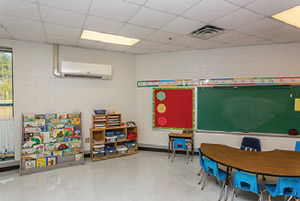HVAC Makes Energy Usage Easy to Manage

A quick installation and the ability to control energy usage made Mitsubishi Electric’s HVAC system an easy choice when it came time to replace an inefficient system at Screven Elementary School.
Screven Elementary School in Sylvania, Ga., serves 1,400 Pre-K to fifth-graders. The 143,000-square-foot facility was built in 1989. A renovation of the school in 2002 took care of many issues, but left a dated and inefficient HVAC system sorely needing replacement. A CITY MULTI Variable Refrigerant Flow (VRF) zoning system from Mitsubishi Electric US, Inc. Cooling & Heating Division (Mitsubishi Electric) provided an efficient, cost-saving solution.
The pipes of the building’s original water-source heat pump system eventually deteriorated. William Bland, superintendent, Screven County School System, says, “There was no question about the need for a renovation of the HVAC system at the elementary school.”
Pruett, Ford & Associates, Inc., Augusta, Ga., was called in to specify the system. Bob Pruett, partner, supported the choice of a Mitsubishi Electric system because “we felt it would be less maintenance.” If one part of the previous system needed to be serviced, the whole system had to be shut down. “The Mitsubishi Electric system is compartmentalized, though, so if you lose a compressor you might lose part of a system, but never the whole system,” says Pruett.
The installation, completed in less than 12 weeks, took place over the summer when school was not in session. Dixon says, “It went unbelievably. If there was a problem we made a phone call and someone was there — more times than not — within the same day. It was remarkable.”
The VRF system allows Preston Dees, director of school safety and energy manager, Screven County School System, to monitor and control the cooling and heating in each classroom. Dees says, “Now we’re on a control system and we can manage our energy usage.” Controlling energy usage throughout the school from a centralized controller offers ease and cost savings. The savings in the first two years post-renovation have been substantial.
www.mehvac.com
This article originally appeared in the issue of .